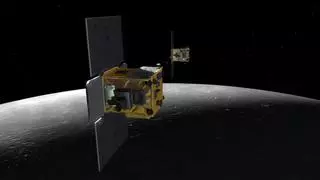
Earth's Moon. (Image Credit: NASA/JPL/USGS)
Researchers have detected traces of water within the crystalline structure of one of the oldest rocks obtained from the Apollo missions on Moon.
The new findings indicate that the early Moon was wet and that water there was not substantially lost during the Moon’s formation.
The lunar highlands are thought to represent the original crust, crystallised from a magma ocean on a mostly molten early Moon, according to a University of Michigan study.
Researchers used Infrared spectroscopy to analyse the water content in grains of plagioclase feldspar from lunar anorthosites — highland rocks composed of more than 90 per cent plagioclase.
The bright-coloured highlands rocks are thought to have formed early in the Moon’s history when plagioclase crystallised from a magma ocean and floated to the surface.
The infrared spectroscopy work detected about 6 parts per million of water in the lunar anorthosites.
“The surprise discovery of this work is that in lunar rocks, even in nominally water-free minerals such as plagioclase feldspar, the water content can be detected.
“It’s not ‘liquid’ water that was measured during these studies but hydroxyl groups distributed within the mineral grain,” researcher Youxue Zhang said in a statement.
“We are able to detect those hydroxyl groups in the crystalline structure of the Apollo samples,” said study’s first author Hejiu Hui from the University of Notre Dame.
The hydroxyl groups the team detected are evidence that the lunar interior contained significant water during the Moon’s early molten state, before the crust solidified, and may have played a key role in the development of lunar basalts.
The results also contradict the predominant lunar formation theory — that the Moon was formed from debris generated during a giant impact between Earth and another planetary body, approximately the size of Mars.
“Because these are some of the oldest rocks from the Moon, the water is inferred to have been in the Moon when it formed,” Zhang said.
“That is somewhat difficult to explain with the current popular moon-formation model, in which the Moon formed by collecting the hot ejecta as the result of a super-giant impact of a martian-size body with the proto-Earth.
“Under that model, the hot ejecta should have been degassed almost completely, eliminating all water,” Zhang said.
More Like This
Published on February 18, 2013





Comments
Comments have to be in English, and in full sentences. They cannot be abusive or personal. Please abide by our community guidelines for posting your comments.
We have migrated to a new commenting platform. If you are already a registered user of TheHindu Businessline and logged in, you may continue to engage with our articles. If you do not have an account please register and login to post comments. Users can access their older comments by logging into their accounts on Vuukle.